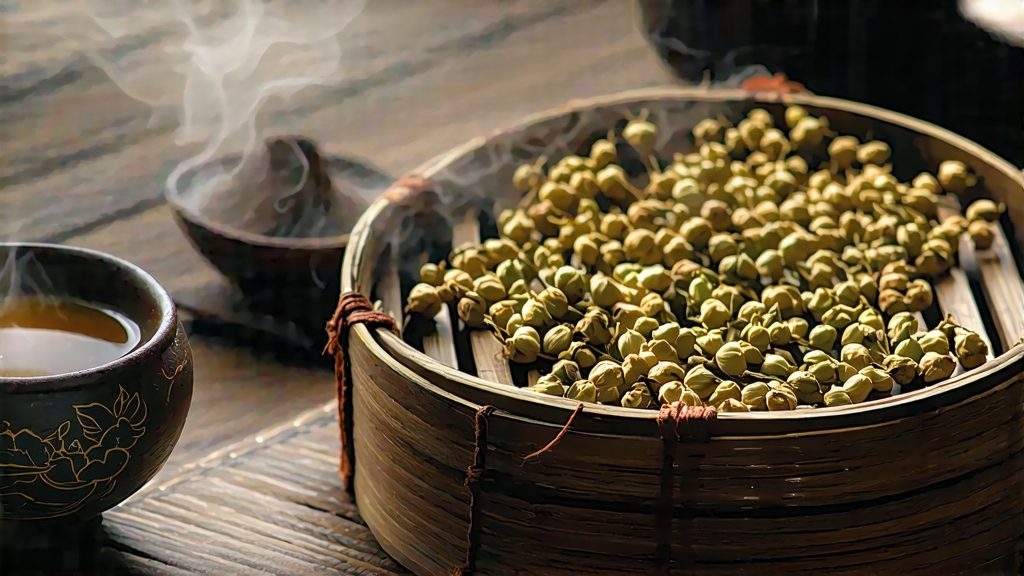
Tucked away in the cloud-veiled highlands of Ya’an, Sichuan, Meng Ding Huang Ya has been quietly perfecting its golden hue for twelve centuries. To most tea lovers outside China “yellow tea” is a colour, not a category; yet this single bud-and-leaf pluck from the misty summit of Mount Meng is the style’s most fragrant ambassador, a living relic that once travelled the Tea-Horse Road to Lhasa and the imperial courts of Chang’an. Understanding Meng Ding Huang Ya is therefore a shortcut to understanding how Chinese artisans learned to slow time itself, coaxing fresh leaf through an extra, whisper-soft “sealed yellowing” that turns green into amber and briskness into butterscotch.
History: from monkish gift to imperial tribute
Buddhist monks settled Mount Meng during the Tang dynasty (618-907 CE) and began offering the earliest “yellow sprout” to the emperor as a symbol of earthly transcendence. By the Song (960-1279) the tea had become one of the fourteen officially listed tribute teas; carriers wearing bamboo hats sprinted 1 400 m down stone steps to Ya’an, where fast horses rushed the spring harvest to the capital in less than three days. When Ming emperors shifted taste to loose leaf, Meng Ding Huang Ya survived because its gentle oxidation suited the new fashion for “clear, sweet, and non-astringent” liquors. After 1949 the garden was nationalised, then forgotten during the green-tea boom, and only in 2006 did a handful of families revive the old bamboo-firing technique. Today fewer than 3 000 kg of authentic summit-grade Huang Ya are made each April, making it rarer per gram than silver tips of Darjeeling.
Micro-terroir: why the mountain makes yellow possible
Mount Meng thrusts 1 456 m above the Sichuan basin, trapping a 78 % average humidity inside a perpetual cloud belt. The short-wave UV light at this altitude increases amino acids, especially theanine, while cool nights slow growth so that the standard picking—one tender bud sheathed by an unopened leaf—remains feather-light at 0.18 g. The soil is a crumbly quartz-rich yellow loam (the same colour that inspired the tea’s name) that drains instantly yet holds warmth, forcing roots to dive deep for minerals. These combined stresses create a raw leaf that is already faintly sweet, the blank canvas on which the yellowing step will paint its honeyed notes.
Plucking calendar: the 10-day window
Authentic Meng Ding Huang Ya is made only between the Qingming festival (4 April) and Grain Rain (20 April). Workers climb 600-year-old stone paths before dawn so that leaf reaches the village workshop by 8 a.m., still cool with mountain dew. Picking follows the “three same” rule: same length (2.5 cm), same colour (jasper green), same pubescence (silky white down). Anything longer or older is diverted into cheaper Meng Ding green tea, guaranteeing that Huang Ya’s raw material carries exactly 68 % moisture, the sweet spot for the enzymatic magic that follows.
Craft: the lost 48 hours between green and yellow
Yellow tea is often described as “green tea with an extra step,” but that step—men huang, sealed yellowing—is a high-wire act between microbiology and choreography. The leaf is first wok-fired at 160 °C for 3 min to kill the oxidative enzymes (exactly like green tea), but instead of immediate rolling it is piled in bamboo trays, covered with damp linen, and left to sweat. During the next 6–8 h the residual moisture re-activates non-enzymatic browning: chlorophyll breaks down into pheophytin, catechins dimerise, and a faint lactic fermentation lends a yoghurt-like whiff. The pile is turned every 30 min so that the core temperature never exceeds 38 °C; one degree hotter and the leaf tips into black tea territory, one degree cooler and the colour stays stubbornly green. This cycle—fire, sweat, rest—is repeated three times over 48 hours, shrinking the leaf to 60 % of its original weight and turning it the colour of antique parchment. Finally the tea is hand-rolled into sparrow-tongue shapes and given a last charcoal bake at 55 °C for 40 min, locking in the chestnut aroma that connoisseurs call “honey over bamboo.”
Grades